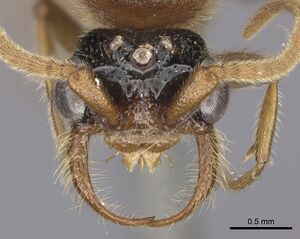Neivamyrmex spoliator
| Neivamyrmex spoliator | |
|---|---|

| |
| Scientific classification | |
| Kingdom: | Animalia |
| Phylum: | Arthropoda |
| Class: | Insecta |
| Order: | Hymenoptera |
| Family: | Formicidae |
| Subfamily: | Dorylinae |
| Genus: | Neivamyrmex |
| Species: | N. spoliator |
| Binomial name | |
| Neivamyrmex spoliator (Forel, 1899) | |
This species is only known from males and has yet to be associated with queens or workers.
Identification
Distribution
Latitudinal Distribution Pattern
Latitudinal Range: 17.514° to 10.33333°.
| North Temperate |
North Subtropical |
Tropical | South Subtropical |
South Temperate |
- Source: AntMaps
Distribution based on Regional Taxon Lists
Neotropical Region: Costa Rica (type locality), Guatemala, Mexico, Panama.
Distribution based on AntMaps
Distribution based on AntWeb specimens
Check data from AntWeb
Countries Occupied
| Number of countries occupied by this species based on AntWiki Regional Taxon Lists. In general, fewer countries occupied indicates a narrower range, while more countries indicates a more widespread species. |

|
Estimated Abundance
| Relative abundance based on number of AntMaps records per species (this species within the purple bar). Fewer records (to the left) indicates a less abundant/encountered species while more records (to the right) indicates more abundant/encountered species. |

|
Biology
Jack Longino: This species is known from males only. During an 18-month program of sampling using blacklight traps at La Selva, as part of the ALAS project, males occurred in 14 different samples, all in the months of January to May. Two males were also collected in Malaise traps, one in March and one in July. Two males were collected at the 300m site (Cantarrana) on the Barva transect in Braulio Carrillo National Park, one in a Malaise trap and one in a flight intercept trap, in April. In Monteverde, I have twice collected males. One was flying at dusk, at 1715hrs, and I caught it by hand. The other was at a house light. The collections were in April and June.
Castes
Images from AntWeb
  
| |
| Male (alate). Specimen code casent0249506. Photographer Will Ericson, uploaded by California Academy of Sciences. | Owned by PSWC, Philip S. Ward Collection. |
     
| |
| Male (alate). Specimen code inb0003619508. Photographer Will Ericson, uploaded by California Academy of Sciences. | |
Nomenclature
The following information is derived from Barry Bolton's Online Catalogue of the Ants of the World.
- spoliator. Eciton spoliator Forel, 1899c: 29 (m.) COSTA RICA.
- Type-material: holotype male.
- Type-locality: Costa Rica: (no further data) (A. Alfaro).
- Type-depository: MSNG.
- Combination in E. (Acamatus): Emery, 1900a: 187;
- combination in Neivamyrmex: Borgmeier, 1953: 8.
- Status as species: Emery, 1900a: 178 (in key); Wheeler, W.M. 1908e: 416; Emery, 1910b: 27; Menozzi, 1927c: 267; Smith, M.R. 1938b: 158; Borgmeier, 1939: 416; Borgmeier, 1955: 639 (redescription); Kempf, 1972a: 159; Watkins, 1976: 23 (in key); Watkins, 1982: 213 (in key); Bolton, 1995b: 291; Palacio, 2019: 621.
- Distribution: Colombia, Costa Rica, El Salvador, Guatemala, Honduras, Mexico, Panama.
Description
References
- Borgmeier, T. 1953. Vorarbeiten zu einer Revision der neotropischen Wanderameisen. Stud. Entomol. 2: 1-51 (page 8, Combination in Neivamyrmex)
- Borgmeier, T. 1955. Die Wanderameisen der neotropischen Region. Stud. Entomol. 3: 1-720 (page 639, see also)
- Emery, C. 1900e. Nuovi studi sul genere Eciton. Mem. R. Accad. Sci. Ist. Bologna (5)8:173-188 (page 187, Combination in E. (Acamatus))
- Forel, A. 1899d. Formicidae. [part]. Biol. Cent.-Am. Hym. 3: 25-56 (page 29, male described)
References based on Global Ant Biodiversity Informatics
- Borgmeier T. 1939. Nova contribuição para o conhecimento das formigas neotropicas (Hym. Formicidae). Revista de Entomologia (Rio de Janeiro) 10: 403-428.
- Borgmeier T. 1955. Die Wanderameisen der neotropischen Region. Studia Entomologica 3: 1-720.
- Dattilo W. et al. 2019. MEXICO ANTS: incidence and abundance along the Nearctic-Neotropical interface. Ecology https://doi.org/10.1002/ecy.2944
- Fernandes, P.R. XXXX. Los hormigas del suelo en Mexico: Diversidad, distribucion e importancia (Hymenoptera: Formicidae).
- Fernández, F. and S. Sendoya. 2004. Lista de las hormigas neotropicales. Biota Colombiana Volume 5, Number 1.
- Kempf, W.W. 1972. Catalago abreviado das formigas da regiao Neotropical (Hym. Formicidae) Studia Entomologica 15(1-4).
- Longino J. et al. ADMAC project. Accessed on March 24th 2017 at https://sites.google.com/site/admacsite/
- Maes, J.-M. and W.P. MacKay. 1993. Catalogo de las hormigas (Hymenoptera: Formicidae) de Nicaragua. Revista Nicaraguense de Entomologia 23.
- O'Keefe S. T., J. L. Cook, T. Dudek, D. F. Wunneburger, M. D. Guzman, R. N. Coulson, and S. B. Vinson. 2000. The Distribution of Texas Ants. The Southwestern Entomologist 22: 1-92.
- Smith M. R. 1936. A list of the ants of Texas. Journal of the New York Entomological Society 44: 155-170.
- Vásquez-Bolaños M. 2011. Lista de especies de hormigas (Hymenoptera: Formicidae) para México. Dugesiana 18: 95-133
- Watkins II, J.F. 1982.The army ants of Mexico (Hymenoptera: Formicidae: Ecitoninae). Journal of the Kansas Entomological Society 55(2): 197-247.
- Watkins J. F., II 1976. The identification and distribution of New World army ants (Dorylinae: Formicidae). Waco, Texas: Baylor University Press, 102 pp

